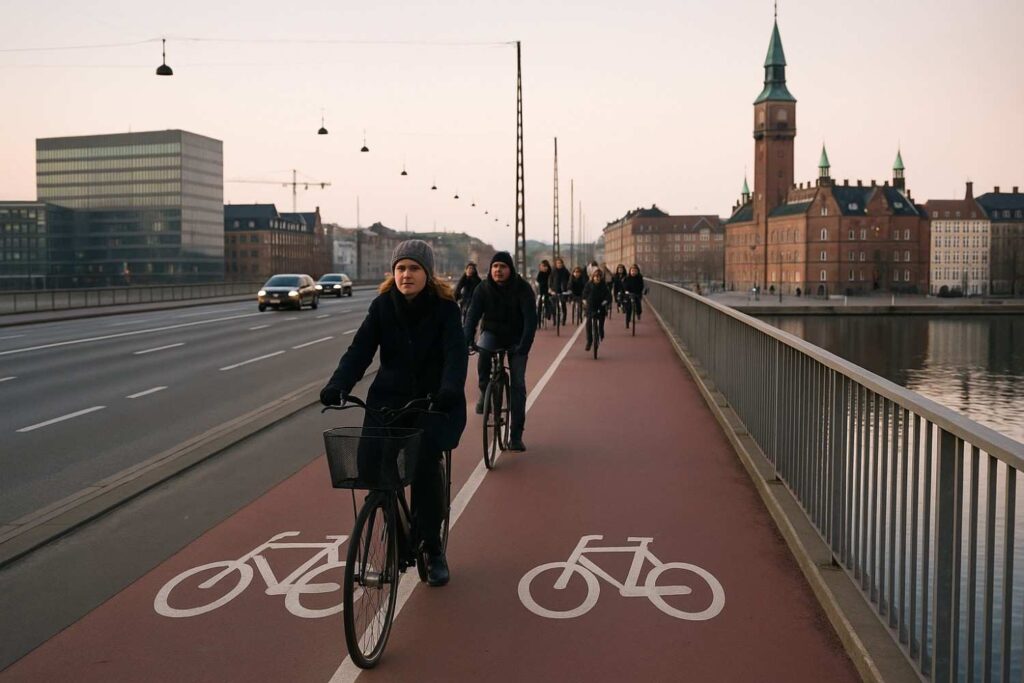In Copenhagen, the numbers tell a story of transformation. The Danish capital now has 675,000 bicycles and only 120,000 cars—a ratio that has turned it into a global symbol of cycling success. This didn’t happen by chance. It resulted from two visionary public policies introduced at different times—Copenhagen’s Cycle Policy (2002–2012) and the Bicycle Strategy (2011–2025)—that together redefined how a modern city could move, live, and breathe.
The city’s journey began with one clear goal: to make cycling safer, faster, and more convenient than driving. The early policies set measurable targets—improving cyclist safety to 80%, cutting negative experiences below 5%, and boosting cycling speed by 10%. But the true revolution lay in infrastructure. In 2002, Copenhagen earmarked one-third of its road budget for cycling—a historic decision that transformed its transport landscape. Over time, this led to record-breaking investments in bike bridges, safe school routes, “green wave” signals, dedicated parking bays, and superhighways for cyclists.
From Vision to Impact: Environment, Health, and Economy
By 2016, bicycles had officially outnumbered cars on Copenhagen’s streets. The outcome was not just cultural—it was multidimensional, influencing the environment, public health, and economy alike. Environmentally, Copenhagen’s cyclists save over 90,000 tonnes of CO₂ annually, equivalent to planting 1.5 million trees or taking 20,000 cars off the road every year. This shift directly supports Denmark’s mission to become carbon neutral by 2025.
Health-wise, the impact of Copenhagen’s cycling policy has been nothing short of extraordinary. According to the World Economic Forum, residents who commute by bicycle collectively take 1.1 million fewer sick days every year, demonstrating how regular physical activity contributes directly to public health. The economic valuation of these health benefits is estimated at €1 for every kilometer cycled, amounting to €616 million in 2016 alone. This represents a form of preventive healthcare on wheels, reducing the burden on hospitals while promoting an active lifestyle.
From an economic perspective, cycling has proven to be a surprisingly profitable mode of transportation. Every 1 kilometer traveled by bike generates a net societal gain of $0.75, and this figure increases to $1.55 when a bike trip replaces a car journey. With citizens cycling an impressive 1.4 million kilometers daily, Copenhagen reaps $1–2 million in direct and indirect economic benefits every single day. Even local businesses benefit—supermarkets and neighborhood stores report higher footfall and spending from cyclists, who tend to shop more frequently and locally.

Lessons for the World: People Over Cars
Copenhagen’s cycling revolution demonstrates what’s possible when policy, planning, and purpose unite behind a shared vision of sustainable living. The city went beyond building bike lanes—it reimagined urban mobility by putting people before cars. Through consistent investment in safe, accessible, and eco-friendly infrastructure, Copenhagen achieved cleaner air, reduced congestion, and improved public health. This people-centric approach has also boosted local economies, encouraging residents to shop and engage within their communities.
As Indian cities battle congestion, rising emissions, and declining air quality, Copenhagen’s model offers a clear lesson: real change begins with policy choices that prioritize people over vehicles. A Copenhagen-style cycling initiative could not only make cities more liveable but also help India move closer to its climate and health goals. The challenge lies in reimagining our streets—one pedal stroke at a time. We need to invest in cycling infrastructure; we need to make cyclists the protagonists of the roads. India has numerous challenges, and cycling can enable us to pedal past the challenges, it won’t be the panacea of the ills, but certainly a big leap in facing common challenges and reaping benefits.
Unlocking the Potential of Cycling in India’s Cities
In major Indian cities, cycling comprises about 1% of daily urban trips in Mumbai and Kolkata, while Bangalore and Chennai also see shares below 2%. Delhi’s share ranges from 1% to 3%, depending on the area and available cycling infrastructure. Despite active campaigns and new public bicycle-sharing schemes, the overall modal share for cycling in these metros remains low, highlighting significant room for growth given improvements in infrastructure and safety.
Adopting a cycling-focused policy inspired by Copenhagen but tailored to India’s unique urban realities could spark transformative benefits across health, economy, and environment. Prioritizing safe, extensive cycling infrastructure would encourage more citizens to choose active mobility, reducing pollution and traffic congestion while improving public health through increased physical activity. Economically, vibrant cycling cultures can lower transportation costs, boost local businesses, and generate jobs in bicycle manufacturing and services. By integrating cycling into India’s urban transport systems with supportive policies, the country can achieve a sustainable, inclusive leap forward that benefits people, cities, and the planet simultaneously.












